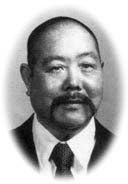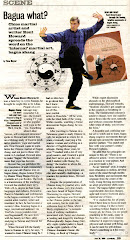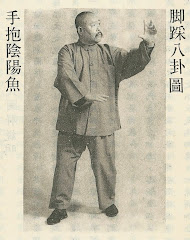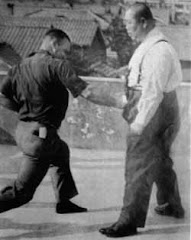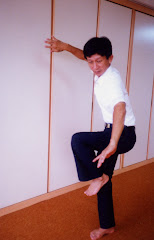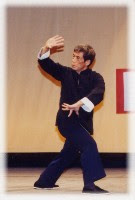 The story of Dong Haiquan found in the Author’s Foreword (below) is one that was popular in Wang Shujin’s native city of Tianjin around the time he was a young man studying martial arts. Variations of the story were also circulated in pulp fiction and magazine articles of the time. But how accurate is the account?
The story of Dong Haiquan found in the Author’s Foreword (below) is one that was popular in Wang Shujin’s native city of Tianjin around the time he was a young man studying martial arts. Variations of the story were also circulated in pulp fiction and magazine articles of the time. But how accurate is the account?Modern scholarship has brought a more critical eye to bear on both Dong’s life and the development of Bagua Zhang. Through extensive historical research a great many new details have been brought to light that constitute a verifiable record of Dong’s connection with the emergence and popularization of Bagua Zhang.
If we look at the facts concerning Dong Haiquan’s long and eventful life, they are startlingly brief. He was born in 1813 in Jujia Wu township, Wenan County, Hebei Province. He began teaching martial arts openly in Beijing in 1870. He died in 1882 at the age of sixty-nine. All of this is a matter of public record. But a great deal more has been discovered about Dong’s life from researching both palace and local records, sifting through the literature of the times, and interviewing descendents from Dong’s home village.
If we look at the facts concerning Dong Haiquan’s long and eventful life, they are startlingly brief. He was born in 1813 in Jujia Wu township, Wenan County, Hebei Province. He began teaching martial arts openly in Beijing in 1870. He died in 1882 at the age of sixty-nine. All of this is a matter of public record. But a great deal more has been discovered about Dong’s life from researching both palace and local records, sifting through the literature of the times, and interviewing descendents from Dong’s home village.
Dong Haiquan was reported to have been a skilled martial artist as a young man growing up in Jujia Wu. It is not known for certain which styles he studied in his youth; though, the types of martial arts most popular in and around his village were known to be Bafan Quan, Hung Quan, Hsing Men, and Jingong Quan. It is known, however, that around 1853 Dong Haiquan left his home in Wenan County and went to live with his cousins in nearby Kaiko County. His older cousin, Dong Xianzhou, was reputed to have been a skilled practitioner of Bafan Quan, and Dong Haiquan may have learned the style from him. This is of interest because Bafan Quan is a Northern Shaolin style that is unique in its use of open palm strikes and other techniques that are found in present day Bagua Zhang.
When Dong Haiquan left Kaiko, he ventured south travelling through several provinces and spending a good deal of time in the mountains. Exactly where he wandered, and what he did, is mostly a matter of conjecture. One thing known for certain is that, somewhere along the line, he joined a sect of Daoism called Quan Zhen (Complete Truth/Reality). Quan Zhen Dao was part of the Lung Men (Dragon Gate) school of Daoism that was established by Zhou Zhangquan. Zhou was credited with developing a method a walking meditation that traversed a circle—often pacing around a tree. The Quan Zhen sect also practiced this type of meditation by walking a particular pattern, like the yin-yang symbol or a figure eight, while chanting a mantra. The reasoning behind the practice was to help calm the mind and eventually realize stillness in motion—both considered precursors to achieving a transcendental state of grace or enlightenment.
The next known whereabouts of Dong Haiquan was when he surfaced in Beijing as a man of middle age. The Stories of his escapades in the city are numerous and varied, but facts are limited. It is known, for example, that he was involved in some way with instructing guards and other personnel in the Imperial Palace. There are many tales told of his exploits there, but, again, most are apocryphal and undocumented. It is a matter of fact, however, that Dong started teaching openly in Beijing around 1870, when he was in his fifties. He taught continuously until his death in 1882, twelve years later.
The memorial stone, or stele, placed at Dong Haiquan’s grave in 1883 lists a group of sixty-six students and/or admirers who were associated with him during his life. Among those names is found a group of students who were referred to as the ‘eight great’ disciples. Their names are: Yin Fu, Cheng Tinghua, Sung Changrong, Ma Guei, Liu Dekuan, Liu Fengchun, Ma Weiqi, and Zhang Zhaodong. Several of these disciples became respected teachers in their own right and passed the art along to many students. Dong’s two senior students, Yin Fu and Cheng Tinghua have their names associated with two styles of Bagua Zhang that are still thriving today. The latter named, Zhang Zhaodong, opened a martial arts school in Tianjing where Wang Shujin studied for eight years.
There were, of course, a great many other students who learned from Dong Haiquan or, at least, studied in his school. Some sources have placed that number in the hundreds. Many of these devotees went on to found their own schools and produce students who, in turn, became famous instructors themselves.
There are other elements of Wang Shujin’s retelling of the Dong Haiquan legend that cannot be corroborated. One is the story of Dong learning Bagua Zhang from two mysterious Daoist adepts; and the other is the tale of Dong becoming a eunuch through forced castration.
The Story of Dong Haiquan being taught Bagua Zhang as a fully developed martial art by two mountain-dwelling Daoist recluses has all of the basic elements of many a martial art legend in China. All you need to do is change the names, and a few circumstances, and you have Zhang Sanfong creating Taiji Quan from a dream or Shaolin priests learning their art from an Indian monk. Chinese love to shroud their origin myths in the mists of antiquity. It lends them a certain air of distinction and provides an unassailable historical precedent.
There are several elements of this legend, however, that do not stand up well in the face of modern research. First, there has been no discoverable trace in history or literature of two Daoists named, Gu Jici and Shang Daoyuan in the Mount Ermei region of Szechuan Province. Researchers who combed those fabled mountains interviewing present day Daoist adepts found no temple records containing either name, nor of any Daoist recluses of that time who were known to teach martial arts. Second, facts point to Dong learning martial arts in his youth that contained many elements found in modern Bagua Zhang. Third, Dong was a member of the Quan Zhen sect of Daoism and learned a method of walking meditation that resembles Bagua Zhang circle walking patterns and stepping. Finally, Dong Haiquan seemed quite happy to allow the origins of Bagua Zhang to be obscured by legend rather than have contemporaries believe that he had synthesized it whole cloth from elemental skills derived from previous training.
The legend of Dong Haiquan becoming a eunuch is a bit more difficult to dismiss out of hand. This story has been retold by third and fourth generation practitioners of Bagua Zhang but not, significantly, by first generation students. There is also no evidence in imperial or local court records of Dong’s forced castration. Castration was known as a common punishment in Chinese history up through the Sui Dynasty, but it was rarely used in the Ming and Ching eras except in extreme cases.
There are several stories about how Dong Haiquan became known as a eunuch. According to the story on his tombstone, he pretended to be a eunuch in order to enter into service in the residence of a Manchu prince. Another such tale has him pretending to be a eunuch in order to assassinate the emperor (a plot which obviously failed). There is yet another story which has Dong actually undergoing the operation on his on volition in order to obtain employment in the palace. Finally, there is Wang Shujin’s version that has Dong involuntarily castrated for some unspecified crime. With a decided lack of corroborating evidence, we are left with examining a few facts about eunuchs to see if they might fit the picture of a great martial artist like Dong Haiquan.
Eunuchs (taijian) were employed in the imperial palace as advisors and servants of the inner circle of the emperor, and especially as retainers for emperor’s concubines and female relatives. They were trusted because of their inability to participate in sexual congress with the ladies of the court. Eunuchs came to their calling voluntarily. Self-inflicted eunuchoidism is a condition involving the surgical removal of the penis, scrotum, and testes. This complete castration of the male genitalia in young males blocked the production of testosterone and the onset of puberty. The lack of testosterone production left eunuchs with: high pitched voices; flaccid musculature; soft rounded bellies; a lack of facial and body hair; and somewhat feminine features. Eunuchs also tended to age prematurely, so a man of forty often looked like one of sixty. Eunuchs were easily identified by their unique appearance. They were also roundly despised by the general population and were often objects of derision and caricature.
No eunuchs in Chinese history were ever known to be soldiers, palace guards, or martial artists. Dong Haiquan, on the other hand, was described as an unusually strong and robust figure with the “back of a horse.” His reputed great strength, agility, and athletic prowess would seem to fly in the face of accusations of his being a eunuch. There is also the matter of his great success in attracting some of Beijing’s best young martial artists to his inner circle. It is difficult to see how a eunuch, universally reviled among the citizenry, could ever achieve such a feat.
The last question to take up in our quest for the real Dong Haiquan is whether he popularized an art that had existed previously, or if he invented his own style by marrying disparate methodologies into one cohesive system. This task is made more difficult when you consider that Dong, when asked by his disciples where he learned Bagua Zhang, would comment that he received his art from “a man who lived in the mountains.” If the system existed before Dong Haiquan, we know it was not called Bagua Zhang. That name was unknown before his time. In fact, Dong’s first generation students stated the original name for the system was Zhuan Zhang (Rotating palms). Later it was expanded to Bagua Zhuan Zhang. Finally, probably near the end of Dong’s life, or perhaps even posthumously, it was shorted to Bagua Zhang.
Several martial systems pre-dating Bagua Zhang have been examined as possible precursors to the art, but none contain all of the elements present in Dong’s method. Of course, you can take Bagua Zhang apart piece by piece and identify known techniques that pre-existed the art; but since there are only so many ways to move the human body, such similarities are to be expected. There are also certain styles of Bagua Zhang that claimed to have been established before Dong began teaching (some by many hundreds of years), but exhaustive investigation has ruled them out one by one as being wholly derived from Bagua Zhang and Dong Haiquan.
We can probably never say with absolute certainty if Dong Haiquan learned his art from another source, and merely popularized it, or whether he synthesized techniques learned from several sources and created an entirely new martial system. In any event, Dong was certainly good at marketing his product and keeping the source, as he played his cards, very close to the vest. As Lao Tzu once said, “The Sage wears rough clothing and embraces the jewel within!”
